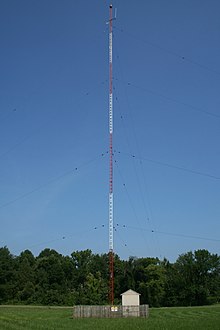
Back موجة متوسطة Arabic Ona mitjana Catalan Střední vlny Czech Mellembølgebåndet Danish Mittelwellenrundfunk German Μεσαία κύματα Greek Onda media Spanish Kesklaine Estonian موج متوسط Persian MW (taajuusalue) Finnish

Medium wave (MW) is a part of the medium frequency (MF) radio band used mainly for AM radio broadcasting. The spectrum provides about 120 channels with more limited sound quality than FM stations on the FM broadcast band. During the daytime, reception is usually limited to more local stations, though this is dependent on the signal conditions and quality of radio receiver used. Improved signal propagation at night allows the reception of much longer distance signals (within a range of about 2,000 km or 1,200 miles). This can cause increased interference because on most channels multiple transmitters operate simultaneously worldwide. In addition, amplitude modulation (AM) is often more prone to interference by various electronic devices, especially power supplies and computers. Strong transmitters cover larger areas than on the FM broadcast band but require more energy and longer antennas. Digital modes are possible but have not reached momentum yet.
MW was the main radio band for broadcasting from the beginnings in the 1920s into the 1950s until FM with a better sound quality took over. In Europe, digital radio is gaining popularity and offers AM stations the chance to switch over if no frequency in the FM band is available, (however digital radio still has coverage issues in many parts of Europe).[citation needed] Many countries in Europe have switched off or limited their MW transmitters since the 2010s.
The term is a historic one, dating from the early 20th century, when the radio spectrum was divided on the basis of the wavelength of the waves into long wave (LW), medium wave, and short wave (SW) radio bands.